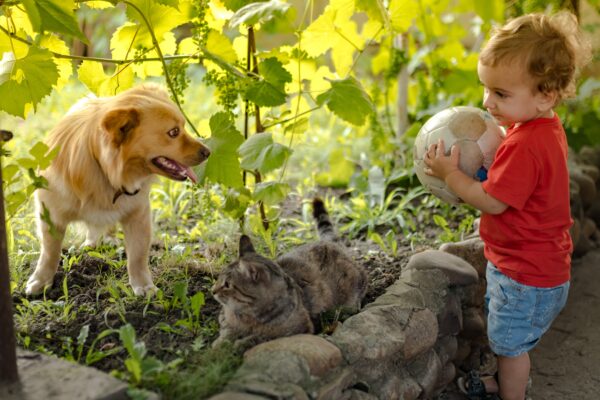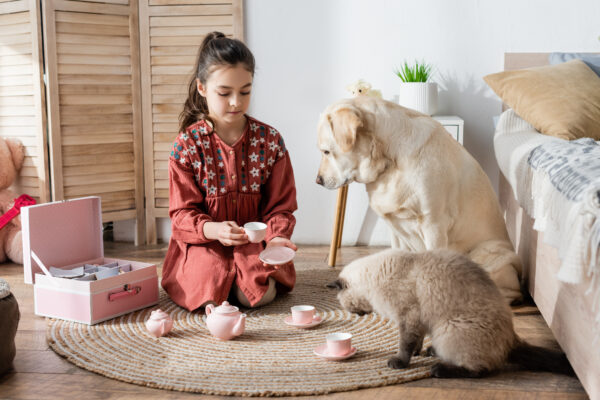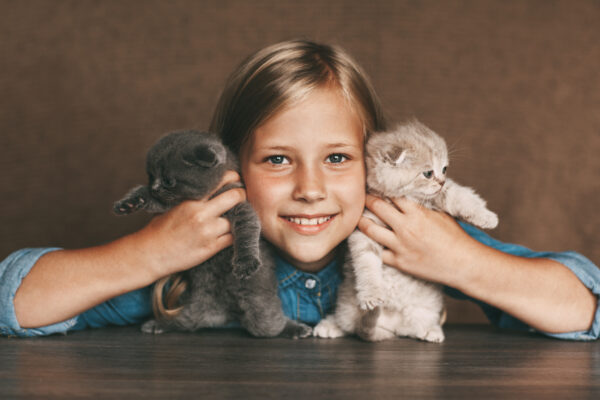p { font-size: 18px; line-height: 1.6; } table { width: 100%; border-collapse: collapse; } table, th, td { border: 1px solid black; } caption { font-weight: bold; margin-bottom: 10px; } th, td { padding: 10px; text-align: left; } h2, h3 { color: #2E8B57; } ul { margin-left: 20px; }
Welcoming a new baby into your family is one of life’s most joyous and transformative experiences to Introduce Your Newborn to Pets. However, if you’re a pet owner, this exciting milestone comes with additional considerations. Your dog or cat, accustomed to a certain routine and environment, will soon encounter new sounds, smells, and changes that can be unsettling. This comprehensive guide provides valuable insights, practical steps, and expert advice to ensure a smooth and safe introduction between your newborn and your furry friend. By understanding your pet’s needs and taking proactive measures, you can foster a harmonious relationship that enriches your entire family’s life.
Table of Contents
- 1. Preparing Your Pet Before the Baby Arrives
- 2. Essential Training and Behavior Modification
- 3. Setting Up the Environment
- 4. The First Introduction
- 5. Supervision and Safety Measures
- 6. Encouraging Positive Interactions
- 7. Managing Stress and Anxiety
- 8. Common Challenges and Solutions
- 9. When to Seek Professional Help
- 10. Real-Life Success Stories
- 11. Additional Resources
- 12. Conclusion
1. Preparing Your Pet Before the Baby Arrives
1.1 Understanding Your Pet’s Perspective

Pets are creatures of habit, and they thrive on routine and familiarity. The introduction of a new baby brings a plethora of changes that can disrupt their sense of security. Dogs and cats may become anxious or stressed when their environment changes dramatically. Recognizing this, it’s essential to empathize with your pet’s perspective. They may not understand what’s happening, but they will notice shifts in attention, new items appearing in the home, and changes in household dynamics. By acknowledging these potential stressors, you can take steps to minimize anxiety and help your pet adjust more comfortably.
1.2 Health Check-Up
Before your baby’s arrival, schedule a comprehensive veterinary examination for your pet. This visit should include updating vaccinations, deworming, and a general health assessment. Discuss any behavioral concerns with your veterinarian, such as signs of anxiety or aggression. Addressing health issues proactively ensures your pet is in the best possible condition to handle the upcoming changes. Additionally, a healthy pet is less likely to pose health risks to your newborn, as certain parasites and diseases can be transmitted from pets to humans (CDC, 2021).
1.3 Gradual Exposure to Baby Sounds and Smells
Newborns bring unfamiliar sounds and scents that can startle or confuse pets. To acclimate your pet, start playing recordings of baby noises, such as crying, cooing, and giggling. Begin at a low volume and gradually increase it over several weeks. Observe your pet’s reactions and provide treats or positive reinforcement when they remain calm. Introducing baby scents is equally important. Apply baby lotions, powders, or use blankets that have been in contact with other infants to familiarize your pet with these new smells. This gradual exposure helps reduce the shock of sudden changes when the baby arrives.
1.4 Adjusting Routines
Babies often require significant adjustments to household schedules, which can affect your pet’s routine. If you anticipate changes in feeding times, walk schedules, or play sessions, begin implementing these adjustments gradually. For example, if you usually walk your dog in the morning but expect to do so in the afternoon after the baby arrives, start shifting the walk time by 15 minutes each day. Consistency and predictability help reduce stress for pets, making the transition smoother. It’s also beneficial to introduce new caretakers if someone else will take over certain responsibilities, allowing your pet to build trust with them before the baby arrives.
2. Essential Training and Behavior Modification

2.1 Reinforcing Basic Commands (For Dogs)
Ensuring your dog responds reliably to basic commands is crucial for managing interactions with your newborn. Commands such as sit, stay, down, come, and leave it provide you with control over your dog’s behavior in various situations (American Veterinary Medical Association, n.d.). Practice these commands in different environments and with increasing distractions to strengthen your dog’s obedience. Positive reinforcement methods, using treats and praise, are highly effective. Remember that consistency is key; ensure all family members use the same commands and rewards to avoid confusion.
2.2 Addressing Problem Behaviors
Identify any existing behavioral issues that could pose risks or challenges once the baby arrives. Common problems include jumping on people, nipping, excessive barking, or resource guarding. Begin addressing these behaviors well in advance. For example, if your dog jumps up when excited, teach them to sit when greeting people. If your cat tends to scratch furniture, provide appropriate scratching posts and use deterrents on prohibited areas. Consider enlisting the help of a professional trainer or behaviorist for persistent issues. Early intervention increases the likelihood of successfully modifying unwanted behaviors.
2.3 Socialization
Exposing your pet to children and infants under controlled circumstances can significantly reduce fear or anxiety. Arrange supervised interactions with friends or family members who have well-behaved children or babies. Ensure these experiences are positive by rewarding your pet for calm behavior and keeping sessions short to prevent overstimulation. This exposure helps your pet become accustomed to the noises, movements, and scents associated with children, making the eventual introduction to your newborn less overwhelming.
3. Setting Up the Environment

3.1 Creating Safe Spaces
Establishing designated areas for both your pet and your baby is essential for safety and comfort. Create pet-free zones by using baby gates, playpens, or closed doors, particularly in the nursery or areas where the baby will spend significant time. This prevents unsupervised interactions and gives you peace of mind. Conversely, ensure your pet has a secure retreat, such as a crate, bed, or designated room, where they can relax without interruption. This space should be equipped with familiar items like toys and bedding to provide comfort.
3.2 Arranging the Nursery
Allow your pet to explore the nursery before the baby arrives. Supervise them as they sniff and investigate the new furniture and items. This helps reduce curiosity-driven exploration later when the baby is present. If you’re concerned about your cat jumping into the crib, consider installing crib nets or covers designed to prevent pet access. Consistent boundaries established early on teach your pet which areas are off-limits.
3.3 Introducing Baby Equipment
Baby equipment such as strollers, swings, and car seats can be unfamiliar and intimidating to pets. Introduce these items gradually, allowing your pet to inspect them at their own pace. Practice walking with the stroller around the house and on walks with your pet to familiarize them with its presence and movement. If the equipment produces sounds or motions, like a rocking chair or swing, turn them on while your pet is nearby to acclimate them to these new stimuli.
4. The First Introduction

4.1 Initial Meeting Guidelines
The first meeting between your pet and your newborn is a significant moment that requires careful planning. Choose a calm and quiet time when both your pet and baby are relaxed. Have another adult present to manage the pet while you hold the baby. Keep the pet on a leash (for dogs) or within a controlled area (for cats). Allow your pet to approach slowly, sniffing from a safe distance. Speak in soothing tones and offer treats to reinforce positive behavior. Keep the initial interaction brief, gradually increasing exposure as your pet shows comfort.
4.2 Reading Body Language
Understanding your pet’s body language is crucial for identifying signs of stress, fear, or aggression. For dogs, signs of discomfort may include stiff posture, pinned-back ears, lip licking, yawning, or growling. Cats may exhibit dilated pupils, flattened ears, twitching tails, or hissing. If you observe any of these signals, calmly remove your pet from the situation without punishment. Recognizing and respecting these signs prevents negative experiences and builds trust between you and your pet.
4.3 Positive Reinforcement
Positive reinforcement is a powerful tool for encouraging desired behaviors. Reward your pet with treats, praise, or gentle petting when they exhibit calm and appropriate behavior around the baby. This creates a positive association with the baby’s presence. Avoid scolding or punishing your pet during introductions, as this can lead to negative associations and increase anxiety. Consistency in rewarding good behavior reinforces trust and fosters a harmonious relationship.
5. Supervision and Safety Measures

5.1 Never Leave Them Unattended
It’s imperative to never leave your pet alone with your newborn, regardless of your pet’s temperament or previous behavior. Even well-trained and gentle pets can react unpredictably to a baby’s sudden movements or sounds. Continuous supervision allows you to intervene immediately if necessary, ensuring the safety of both your baby and your pet.
5.2 Physical Barriers
Utilize physical barriers to manage interactions and provide additional safety. Baby gates can prevent pets from entering certain rooms or approaching the baby unsupervised. Ensure that cribs and bassinets are secure and inaccessible to pets. For cats, consider using crib tents or nets specifically designed to prevent them from jumping into the crib. These measures help create a controlled environment where interactions can be monitored effectively.
5.3 Hygiene Practices
Maintaining strict hygiene is essential to protect your baby from potential pathogens that pets may carry. Wash your hands thoroughly after handling your pet, cleaning litter boxes, or picking up after your dog. Keep pet feeding areas and litter boxes clean and away from areas where the baby crawls or plays. Regularly wash pet bedding and toys to reduce the risk of bacterial or parasitic transmission (CDC, 2020). Additionally, ensure your pet is up-to-date on flea, tick, and worm preventatives.
6. Encouraging Positive Interactions
6.1 Incorporating Pets into Baby Activities
Including your pet in daily baby activities can strengthen their bond and reduce feelings of exclusion. During feeding times, allow your pet to sit nearby, reinforcing calm behavior with treats or praise. On walks, bring your dog along with the stroller, ensuring they are comfortable walking beside it. This shared time helps your pet associate positive experiences with the baby and reinforces their role within the family unit.
6.2 Gentle Petting and Touch
When appropriate, allow your pet to sit next to you while you hold the baby. Gently pet your pet with one hand while holding the baby with the other, ensuring the baby is safe and secure. This dual attention can reassure your pet that they are still valued and loved. Over time, these moments can foster a gentle and protective attitude toward the baby.
6.3 Consistent Attention
It’s easy to become consumed with the demands of a newborn, but it’s crucial to maintain consistent attention and affection for your pet. Set aside dedicated time each day for play, grooming, or cuddling with your pet. This consistent interaction helps prevent behavioral issues that may arise from feelings of neglect or jealousy. Remember that a well-adjusted pet contributes positively to the household dynamic.
7. Managing Stress and Anxiety
7.1 Recognizing Signs of Stress
Pets may exhibit various signs when they are stressed or anxious. Common indicators include excessive panting (in dogs), drooling, hiding, decreased appetite, increased vocalization, or changes in elimination habits, such as accidents in the house. Cats may over-groom or display aggression. Recognizing these signs early allows you to address the underlying causes promptly, preventing escalation of stress-related behaviors.
7.2 Providing Comfort
Offering comfort and reassurance can alleviate your pet’s stress. Provide familiar items such as their favorite toys, blankets, or bedding. Consider using pheromone diffusers like Adaptil for dogs or Feliway for cats, which release calming scents that mimic natural pheromones (Shepherd, 2009). Calming treats or supplements containing ingredients like L-theanine or chamomile may also be beneficial, but always consult your veterinarian before introducing new products.
7.3 Establishing a Routine
Maintaining a consistent routine provides a sense of security for your pet amidst household changes. Try to keep feeding times, walks, and play sessions as regular as possible. Predictability helps reduce anxiety by allowing your pet to anticipate what comes next. If deviations from the routine are unavoidable, introduce them gradually and provide extra attention during these times to reassure your pet.
8. Common Challenges and Solutions
8.1 Jealousy and Attention-Seeking Behavior
Pets may exhibit attention-seeking behaviors such as barking, whining, jumping, or destructive actions when they feel neglected. To mitigate this, ensure your pet receives adequate one-on-one time daily. Incorporate training sessions, playtime, or grooming into your schedule. Positive reinforcement for appropriate behavior and ignoring attention-seeking actions (when safe to do so) can help redirect their focus.
8.2 Fear or Aggression Towards the Baby
If your pet shows fear or aggression toward the baby, it’s crucial to address it immediately. Signs may include growling, hissing, snapping, or avoidance behaviors. Do not punish your pet, as this can worsen fear and erode trust. Instead, consult a certified animal behaviorist who can assess the situation and develop a tailored behavior modification plan. Early intervention increases the likelihood of successful resolution.
8.3 Resource Guarding
Resource guarding involves a pet becoming possessive over food, toys, or specific areas. This behavior can pose risks when a baby becomes mobile. Teach your pet the “leave it” and “drop it” commands to relinquish items willingly. Practice trading games where you offer a high-value treat in exchange for the guarded item. Ensure that your pet’s resources are in areas inaccessible to the baby to prevent confrontations.
9. When to Seek Professional Help
9.1 Persistent Behavioral Issues
If your pet’s behavioral issues persist despite your efforts, or if they escalate, it’s time to seek professional assistance. A certified animal behaviorist or a qualified trainer can provide expert guidance. They will evaluate your pet’s behavior, identify triggers, and develop a customized plan to address the issues. Professional intervention is particularly important for aggressive behaviors to ensure the safety of your family.
9.2 Health Concerns
Changes in your pet’s behavior may be indicative of underlying health problems. Symptoms such as lethargy, loss of appetite, excessive thirst, or changes in elimination habits warrant a veterinary examination. Medical conditions like thyroid imbalances, pain, or neurological issues can affect behavior. Addressing health concerns promptly not only improves your pet’s well-being but may also resolve associated behavioral problems.
10. Real-Life Success Stories
10.1 Case Study: Successful Introduction of a Dog and Newborn
A couple with a five-year-old Labrador Retriever named Max prepared for their baby’s arrival by reinforcing obedience training and gradually introducing baby-related stimuli. They played recordings of baby sounds and allowed Max to explore the nursery. After the baby was born, they brought home a blanket with the baby’s scent for Max to investigate. The first introduction was supervised and positive, with Max rewarded for calm behavior. Over time, Max formed a strong bond with the child, often lying beside the crib and alerting the parents when the baby woke up. This successful integration was attributed to thorough preparation and consistent positive reinforcement (Westgarth et al., 2012).
10.2 Case Study: Cat Adjusting to a Newborn
An indoor cat named Whiskers exhibited signs of stress when his owners brought home their newborn daughter. Whiskers began hiding and showed decreased appetite. The family consulted their veterinarian, who recommended using a pheromone diffuser and creating elevated spaces where Whiskers could observe without feeling threatened. They also ensured Whiskers received daily playtime and attention. Gradually, Whiskers became more comfortable, resuming normal eating habits and even curiously approaching the baby during supervised interactions. The family’s patience and proactive measures facilitated a smooth adjustment.
11. Additional Resources
- ASPCA: Dogs and Babies – Comprehensive advice on preparing dogs for a new baby.
- AVMA: Animals and Children Safety – Guidelines for safe interactions between pets and children.
- Family Paws Parent Education – Professional programs and resources for expecting families with pets.
- CDC: Healthy Pets, Healthy People – Information on reducing health risks from pets to humans.
- Dog Star Daily – Training resources and expert articles on pet behavior.
12. Conclusion
Introducing your newborn to your dog or cat is a significant event that requires thoughtful preparation, patience, and understanding. By taking proactive steps to prepare your pet, reinforcing positive behaviors, and maintaining consistent routines, you can foster a safe and loving relationship between your child and your furry family member. Remember that each pet is unique, and adjustments may take time. Monitoring interactions closely, addressing challenges promptly, and seeking professional help when necessary are key components of a successful integration. With dedication and care, your household can enjoy harmony and mutual affection among all its members, enriching your family’s life for years to come.
For all your pet care needs, including premium toys, training aids, calming products, and safety accessories, visit Flawless Cuties, your trusted partner in pet care.
Travel Essentials for Pets
If you’re planning to travel with your pet during this transitional period, it’s important to ensure their comfort and security. From secure carriers to calming aids, having the right travel essentials can make a significant difference in your pet’s experience.
Can I Pet That Dog? A Comprehensive Guide to Safe and Enjoyable InteractionsObedience Puppy Training: A Step-by-Step GuideTop 10 Best Dog Breeds for Apartments: A Comprehensive GuideThe Best Homemade Dog Food Recipes: A Comprehensive GuideI Don’t Want to Hit My Dog, But I Want Them to Obey – What Should I Do? Here’s How to Train Your Dog Positively
References
- American Veterinary Medical Association (AVMA). (n.d.). Pets and Children. Retrieved from https://www.avma.org/resources-tools/pet-owners/petcare/animals-children
- American Veterinary Society of Animal Behavior (AVSAB). (2011). How to Prepare Your Dog for a New Baby. Retrieved from https://www.avsab.org/…/How-to-Prepare-Your-Dog-for-a-New-Baby-Handout-2011.pdf
- Centers for Disease Control and Prevention (CDC). (2020). Healthy Pets, Healthy People. Retrieved from https://www.cdc.gov/healthypets/pets/dogs.html
- Centers for Disease Control and Prevention (CDC). (2021). Cats. Retrieved from https://www.cdc.gov/healthypets/pets/cats.html
- Shepherd, K. (2009). Behavioural medicine as an integral part of companion animal practice. Journal of Small Animal Practice, 50(9), 447-453. doi:10.1111/j.1748-5827.2009.00808.x
- Westgarth, C., Pinchbeck, G. L., Bradshaw, J. W. S., Dawson, S., Gaskell, R. M., & Christley, R. M. (2012). Dog-human and dog-dog interactions of 260 dog-owning households in a community in Cheshire. Veterinary Record, 170(19), 493. doi:10.1136/vr.100321
- ASPCA. (n.d.). Dogs and Babies. Retrieved from https://www.aspca.org/pet-care/dog-care/dogs-and-babies

























Jørgen J. Hansen
Aenean volutpat nisl id lorem posuere pretium. Nam scelerisque commodo congue. Proin eu ornare dui. Ut molestie est tellus, vitae iaculis erat iaculis a. Nulla non gravida leo. Nulla consectetur elit quam, vel suscipit tellus pellentesque sed.
Jørgen J. Hansen
Fusce consectetur mauris at eros feugiat, ut luctus arcu maximus. Etiam ac risus volutpat, convallis odio quis, hendrerit quam. Nulla gravida augue nec fringilla rhoncus. Praesent consectetur sed ligula eu luctus. Etiam eget eros ut ex tincidunt ultricies ut ut tortor.